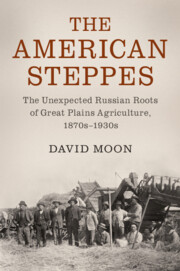Book contents
- The American Steppes
- Studies in Environment and History
- The American Steppes
- Copyright page
- Dedication
- Epigraph
- Contents
- Figures, Maps, and Tables
- Preface
- Acknowledgements
- Notes on the Text
- Dramatis Personae
- Abbreviations
- Maps
- Introduction
- Part I Contexts
- Part II Transfers
- Chapter 4 Wheat
- Chapter 5 Soil Science I
- Chapter 6 Soil Science II
- Chapter 7 Shelterbelts I
- Chapter 8 Shelterbelts II
- Chapter 9 Tumbleweed
- Conclusion
- Archival Collections Cited
- Index
Chapter 8 - Shelterbelts II
from Part II - Transfers
Published online by Cambridge University Press: 23 March 2020
- The American Steppes
- Studies in Environment and History
- The American Steppes
- Copyright page
- Dedication
- Epigraph
- Contents
- Figures, Maps, and Tables
- Preface
- Acknowledgements
- Notes on the Text
- Dramatis Personae
- Abbreviations
- Maps
- Introduction
- Part I Contexts
- Part II Transfers
- Chapter 4 Wheat
- Chapter 5 Soil Science I
- Chapter 6 Soil Science II
- Chapter 7 Shelterbelts I
- Chapter 8 Shelterbelts II
- Chapter 9 Tumbleweed
- Conclusion
- Archival Collections Cited
- Index
Summary
This second chapter on Shelterbelt Project explains that it was launched in the summer of 1934 to address the Dust Bowl, but also because the Forest Service was seeking to get access to New Deal relief funds to make up for the cuts in its research budget. Raphael Zon in St. Paul, Minnesota and Edward Munns in Washington, DC, drew on Russian and Soviet studies to convince the president to approve their plan. Zon and his colleagues also drew on Russian studies in preparing a technical manual for the project. Zon fell out with the project’s administrative director, Paul Roberts in 1935. Thereafter, American experience played a larger role in the project, until it was brought to an end in 1942.
- Type
- Chapter
- Information
- The American SteppesThe Unexpected Russian Roots of Great Plains Agriculture, 1870s–1930s, pp. 312 - 353Publisher: Cambridge University PressPrint publication year: 2020

